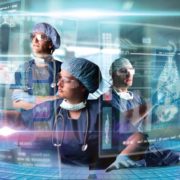THE 4TH INDUSTRIAL REVOLUTION

by Allen Weiss, MD, MBA, FACP, FACR
President and CEO, NCH Healthcare System
Welcome to the 4th Industrial Revolution—the Exponential Age, where the merging of technologies is blurring thelines among the physical, digital and biological spheres and disrupting most traditional industries.
And especially, that includes healthcare. We will also share thoughts about other industries which will be disrupted much the way Polaroid and Kodak went the way of the blacksmith and farrier.
The first industrial revolution began in Britain in the late 18thcentury, with the mechanization of the textile industry. Tasks previously done laboriously by hand in hundreds of weavers’ cottages were brought together in a single cotton mill, and the factory was born. Water power, steam power, and machine tools facilitated the change. Simultaneously, the agricultural revolution added to the improved standard of living.
The second industrial revolution came in the early 20th century, when Ford mastered the moving assembly line and ushered in the assembly are these:
- Place the tools and the men in the sequence of the operation so that each component part shall travel the least possible distance while in the process of finishing.
- Use work slides or some other form of carrier so that when a workman completes his operation, he drops the part always in the same place—which must always be the most convenient place to his hand—and if possible have gravity carry the part to the next workman for his own.
- Use sliding assembling lines by which the parts to be assembled are delivered at convenient distances.
There is still some controversy as to the origin of the assembly line. Ransom Olds, who patented the assembly line concept, used it to build the first mass-produced automobile in 1901—the Oldsmobile Curved Dash.
Others had observed the Swift Slaughter House disassemble carcasses as they were butchered along a conveyor. All these interesting tidbits of information come from various places including the Henry Ford Museum in Ft. Myers.
The third revolution, accelerating in our current century, introduced digitalization of any number of things. Robots produced automobiles more efficiently, 3-D printers constructed parts and tools on demand, and venerable companies such Kodak and Polaroid were essentially put out of business. In healthcare, we have the new wearable devices which measure our daily walking distance, blood sugar, etc. as well as the use of the internet for teleneurology to quickly diagnose and treat strokes with better outcomes than traditional face-to-face care.
And now comes the 4th Industrial Revolution, where the fusion of technologies in healthcare has led to pressing questions revolving around the potential benefits and pitfalls of transparency. For example, does the publication of hospital, healthcare system, and physician metrics help or confuse as people select better quality, improved safety, and less expensive care, translating to better outcomes for themselves?
As transparency takes hold, assisted by the digitalization of healthcare and motivated by higher out-of-pocket costs for those insured with commercial insurance plans such as Florida Blue, Aetna, United, etc., questions like these are increasingly debated.
In other industries consider the changes. Uber, which claims tobe in 66 countries and 449 cities, is now the biggest taxi company in the world. Uber doesn’t own a taxi—it is a software company. When Uber combines with autonomous cars aka driverless or self-driving cars, a few more industries in addition to the taxi/limousine industry will be disrupted.
You won’t want to own or drive a car any longer. You will call up a driverless car with your cell phone, put in your destination, work on your laptop or watch a movie while riding, and arrive safely at your destination. You won’t need to park your car, and you only pay for the car when you are using it. Cities will convert most of the parking to parks and playgrounds, kids won’t ever get a drivers’ licenses, and we will need 90-95 percent fewer cars.
Of particular note is the disruption to the insurance industry as the number of auto accidents drops to 10 percent of what we experience today. Worldwide 1.2 million people die yearly in auto accidents. The trauma avoided helps in so many good ways— suffering lowered, accidental deaths avoided, medical costs reduced. Subsequently, the restructured insurance industry will be able to offer auto insurance at 10percent of the current charges.
The car manufacturers are taking note as most depend on planned obsolesce of the vehicles they sell. Tesla, Apple, and Google are taking the revolutionary approach, whereas the traditional builders of oversized gas consuming SUVs and light trucks are still happily playing in traffic.
In the future automobile manufacturers will be rewarded for how long their cars run, not how quickly they need to be replaced.
There is still more disruption coming for the learned professions. IBM’s Dr. Watson made a public debut winning at Jeopardy, but really a much more important use is for medical diagnosis and treatment.
Watson’s view is based on all available medical knowledge. Human doctors can’t possibly hold this much information in their heads, as knowledge changes over time.
Dr.Watson knows it all and never overlooks or forgets anything. Dr. Watson is accurate and consistent. Given the same inputs, Dr. Watson will always output the same diagnosis.
Inconsistency is a surprisingly large and common flaw among human medical professionals, even experienced ones. And Dr.Watson is always available and never annoyed, sick, nervous, hungover, upset, in the middle of a divorce, sleep-deprived, and so on.
Dr. Watson was very expensive to build and train, but once it’s up and running the cost of doing one more diagnosis with it is essentially zero, unless it orders tests. It has very low marginal cost. And the Doctor is international and multilingual. Over 70 percent of the world will have easy access via mobile technology.
Dr. Watson has also completed law school and has a 90 percent accuracy when answering a legal question as compared to 70 percent accuracy when done by humans. Currently, law school graduates already are struggling to get meaningful jobs.
Talk about further disruption of a profession.3-D printers are already fabricating implantable replacement parts for tracheas, surgical back implants, and soon many more biological and human replacement parts. These printers are also changing industry because many previously hand- or machine-milled parts can be fashioned precisely when needed and customized easily and less expensively than ever before.
We do live in a brave new world which is embracing the fourth industrial revolution. We are reliving Charles Darwin’s famous pronouncement, “It is not the strongest of the species that survives, nor the most intelligent. It is the one that is most adaptable to change.”
I didn’t say everyone was going to be happy with the change, but we are survivors and have been increasing our life expectancy by three months per year. The fourth industrial revolution will help everyone live a longer, happier, and healthier life.




Leave a Reply
Want to join the discussion?Feel free to contribute!